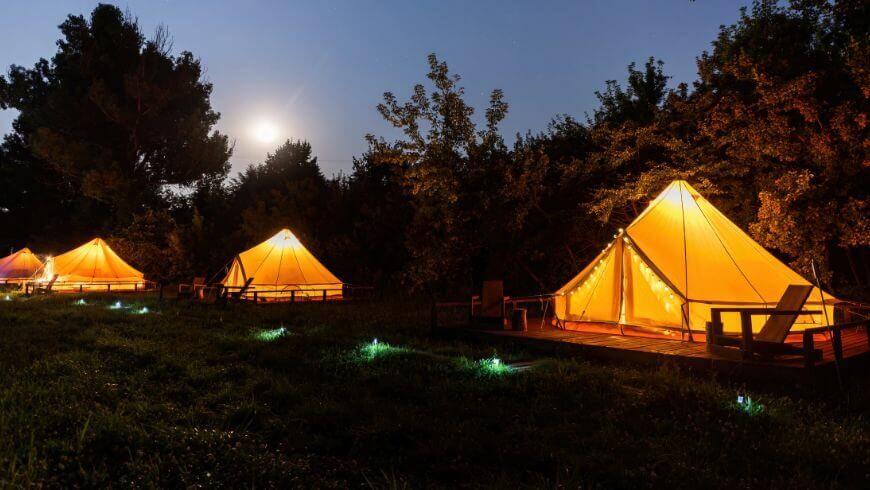The Bahamas’ breathtaking azure waters, pristine beaches, and lush tropical forests beckon as an ideal Caribbean getaway for nature lovers. But how can you answer the call of island adventure while still being an environmentally responsible guest? The solution is enjoying an eco-conscious glamping trip.
With mindful planning, intentional choices, and smart habits once there, you can maximize restorative relaxation and minimize negative impacts to fragile coastal ecosystems. Follow these tips for sustainable luxury camping if the Bahamas is your next destination.
Carefully Choose an Eco-Certified Conservation-Focused Resort
When selecting a Bahamian glamping facility, seek out resorts and accommodations that visibly carry eco-certifications like Green Globe which indicate they follow extensive sustainability programs to actively protect surrounding ocean reefs and natural areas through comprehensive green business policies and practices.
Patronizing resorts where environmental conservation is ingrained into their ethos and mission guarantees sustainability is an operational priority, not just an occasional initiative.
Time Travel During Shoulder Season to Avoid Peak Crowds
If possible, aim to visit the Bahamas during “shoulder season” periods in the Spring (late April-early June) and Fall (late August-early November) to avoid peak tourist crowds.
Visiting during lower demand times means your business helps sustain Bahamian locales year-round without overly straining resources and infrastructure to their limits in the crowded winter high season. Spreading visitor impacts prevents damage concentrated just a few months.
Fly Carbon Neutral and Nonstop to Reduce Emissions
Be sure to offset carbon emissions from your flights by purchasing credible carbon credits equal to or greater than the one-way travel miles of reaching your Bahamian destination through programs like Cool Effect or Sustainable Travel International.
Also select the most fuel-efficient aircraft possible and fly nonstop whenever available to minimize climate impact.
Pack and Travel with Eco-Conscious Intention
Pack wisely to reduce vacation waste before even departing. Avoid miniature amenity bottles and single-use travel-sized plastics. Pack reusable gear like water bottles, insulated mugs, utensil sets, and reusable shopping bags.
Choose skin and hair products like biodegradable sunscreen, reef-safe mineral sunblock, and eco-friendly shampoo. Packing intentionally significantly cuts back on non-recyclable waste.
Dine Local – Choose Bahamian Seafood and Produce
During your glamping stay, seek out opportunities to dine at locally owned restaurants serving up cuisine sourced from other Bahamian producers, fisheries and farms surrounding your island.
Choosing fresh seafood caught daily by Bahamian anglers and produce grown on Bahamian farms supports small island food producers without the emissions of expansive overseas importing and shipping.
Research Excursions’ Environmental Impacts Before Booking
Before reserving any snorkeling, boating, or adventure excursions through your glamping concierge, first research the activities’ sustainability.
For example, select a paddle boarding tour company using boards crafted from sustainable wood over choosing gas guzzling motorboats or jet skis that pollute coral ecosystems.
Generally, aim for excursions focused on nature observation over disruption. Make activity choices judiciously based on green factors.
Reduce Energy Use to Help Conserve Island Resources
Practice water and electricity conservation dutifully during your tent cabin glamping stay by turning off unneeded lights, reusing bath towels, and taking short Navy style showers. Follow Leave No Trace principles on outings.
When visitors collectively reduce resource demands, the islands conserve precious freshwater reserves and cut fossil fuel dependence. Every eco-action helps, even small ones.
Traveling during shoulder and low seasons means it’s easier to find unbelievable last minute cruise deals and vacation packages at reduced costs. Affordable glamping supports sustainable tourism.
Make Environmentally Responsible Purchases and Avoid Waste
Skipping wasteful souvenirs entirely is ideal. But if wanting local mementos, seek arts, crafts and goods sustainably produced in the Bahamas using upcycled, natural or recycled materials to support artisans while avoiding mass production.
Support Reputable Green Non-Profits Before Visiting
Before embarking, research outstanding Bahamian environmental non-profits like Ocean Conservancy or local groups working to protect fragile island nature. Consider donating funds to offset climate impacts of reaching the islands.
Also investigate tour providers who commit part of fees toward environmental causes to ensure your dollars aid sustainability. Choose operators wisely.
Conclusion
With intention, conscious consumerism, and smart eco-friendly habits, glamping sustainably in the Bahamas is absolutely achievable.
Protect the vulnerable places you adore visiting for the future through mindful travel practices that tread lightly, reduce waste, conserve resources, and support local people and conservation initiatives with your funding. Sustainable luxury maintains paradise.

